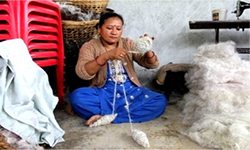
Advocacy, Case Studies, Craftspersons/ Artisanal, Employment/ Livelihood
Banpala of Chuba
Shukla, Sanskruti
Issue 10,Summer 2023
Issue #10, 2023 ISSN: 2581- 9410
The connection between mountains and wool goes beyond a mere geographical correlation. It represents a profound symbiosis between nature, culture, and sustainable practices. The tradition of sheep herding and wool production has shaped the identities of mountain communities, leaving an enduring mark on their history, economy, and cultural heritage.
Wool has a rich and significant historical importance that spans millennia. Its impact on human civilisation can be seen in various aspects, from clothing and textiles to trade and economic development.
Although evidences of wool textiles are rare due to their conditions of preservation, there have been indications of wool being used as one of the earliest fibres. From wool clothes and tools found in excavations of Harappan civilisation[1] (2600-1900 BCE), to the cuneiform records of Mesopotamia[2] that indicate that it was the birthplace of wool. Pastoral communities across the world have reared sheep for wool, milk and meat and continue to do so, especially in the hilly and mountainous regions. With wool, the processes of felting and later weaving were amongst the first to be explored especially amongst the nomadic and transhumant groups of Asia and Europe.
This is a preview. To access all the essays on the Global InCH Journal a modest subscription cost is being levied to cover costs of hosting, editing, peer reviewing etc. To subscribe, Click Here.



